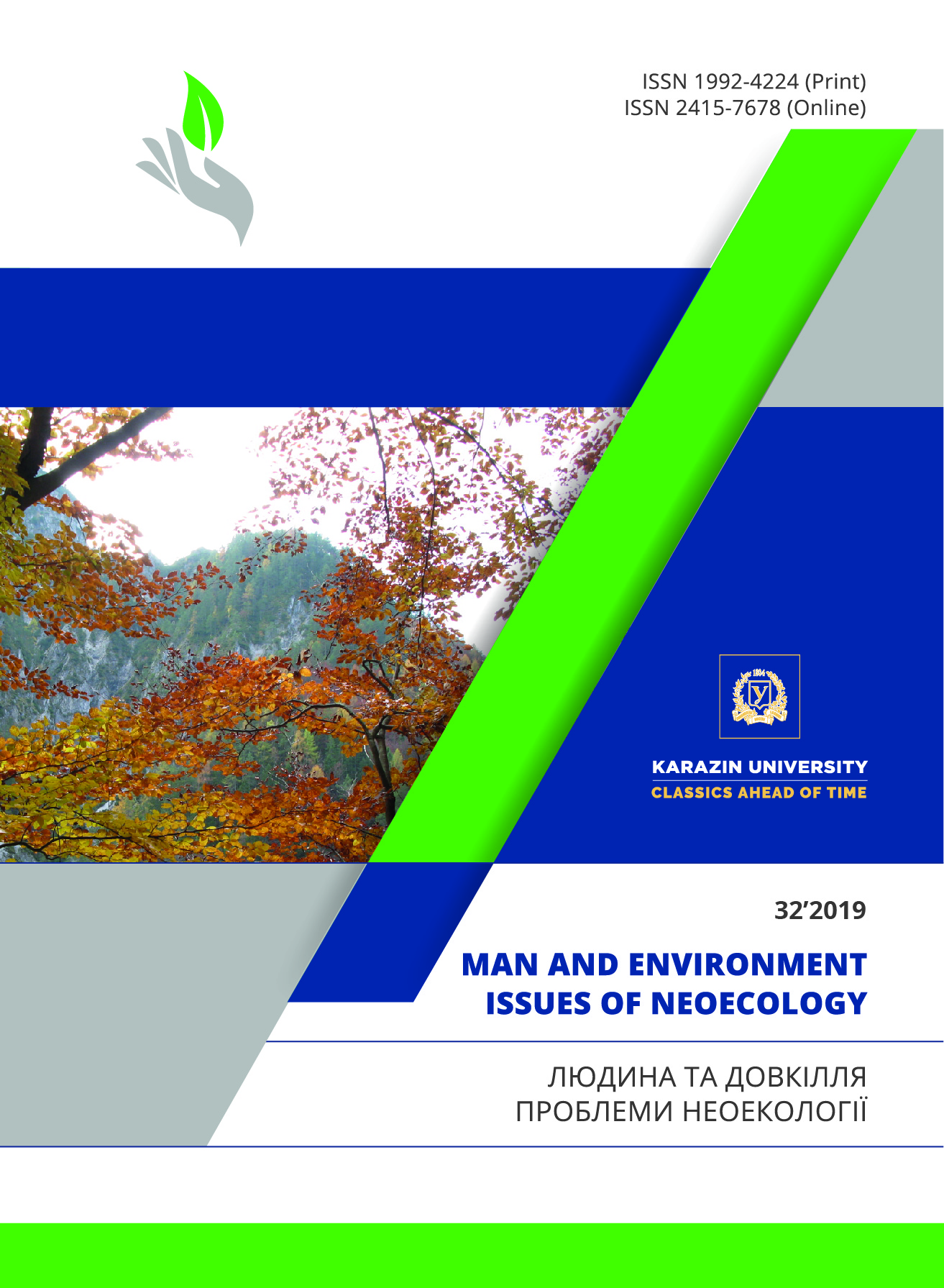Lviv Reservoirs: Current Geo-Ecological Status and Opportunities for its Improvement
Keywords:
water pollution, water protection zones, siltation, eutrophication, shallowing, restorative measuresAbstract
Purpose of the work is to characterize the geo-ecological condition of the reservoirs in Lviv in order to develop recommendations for the protection, conservation and enhancement of their functional use.Methods. Field, cartographic, historical, analysis and synthesis.Results. The geo-ecological state of modern reservoirs of Lviv has been investigated. Water pollution of represented reservoirs has been analyzed according to the fund and statistical materials. In the course of the field researches the physical parameters of the water condition have been analyzed, sources of pollution of reservoirs, clogging and overall assessment of coastal water protection strip shave been identified. Most of the reservoirs of Lviv are characterized by littering of the coastal strip, recreational impact, proximity to roads and residential buildings. The color of the water in the majority of the reservoirs is grayish-yellow, the transparency of the water is low, the smell is marsh or earthy-grassy. Ten of the twenty-three reservoirs under study have strong and over Lviv reservoirs is natural. This contributes to the additional intake of pollutants from the catchment area. Ponds where the basin is covered with an artificial surface (mainly concrete) have better water quality. In particular, Levandivskyi has become the only one to have clean water at the beginning of 2019. In recent years, the water reservoirs of the city have been significantly shallow, due to the construction of catchment areas and the discharge of rainwater to the general sewer. Reservoirs near leased restaurants and recreational facilities are in the best condition. The ponds located in park areas (Stryiskyipark, Pohulianka, Shevchenko-ethnopark., Piskovi Ozera) are in a satisfactory geo-ecological state. The most neglected are the reservoirs of former industrial enterprises, which are under control of district administrations.Conclusions. Irrational use of city reservoirs leads to water pollution, siltation and overgrowth of urban reservoirs, rapid eutrophication, clogging, etc. Taking into consideration the multifunctional importance of reservoirs for the city, recommendations have been developed to improve their geo-ecological state, mainly they are organizational (monitoring the status of reservoirs, introduction of ecological passport of the reservoir, increasing control), technical (separation of rain and municipal sewage, technical care), educational (stands, eco-actions, festivals) measures.
References
Водний Кодекс України від 06.06.1995 із змінами від 21.09.2000, 7.12.2000, 12.12.2001. Розділ І, Глава 1, Ст. 1. URL: https://zakon1.rada.gov.ua › laws
Волошин І., Собечко О. Кислотні опади міста Львова: їх хімізм, металізація природних компонентів : монографія. Львів: ЛДУФК, 2013. 316 с.
Волошин П., Кремінь Н., Книш І. Лімнологічні атракції південного заходу Львова. Геотуризм: прак-тика і досвід: матеріали ІІІ між нар. наук.-практ. конф. (2018, Львів). Львів, 2018. С. 57-58.
Грициняк І. І., Колесник Н. Л. Істотний внесок у дослідження екологічного стану водойм урбанізова-них територій. Рибогосподарська наука України. 2016. № 2. С. 132-134.
Гураль Р.І. Забруднення гідротопів Львова та його околиць іонами важких металів. Наукові записки Державного природознавчого музею. Львів, 2012. Вип. 28. С.69-76.
Державний водний кадастр: облік поверхневих водних об’єктів. Геопортал «Водні ресурси України». URL: http://map.davr.gov.ua:44481/#waterPolygonSidebar (дата звернення 02.03.2018).
Думич О. Я., Данилик І., Сувадло І. Зоопланктофауна озера у парку «Горіховий гай». Сучасний стан і перспективи розвитку ландшафтної архітектури, садово-паркового господарства, урбоекології та фітомеліорації : матеріали міжнар. наук.-практ. конф. (Львів, 4-5 квітня 2019 р.). Львів, НЛТУ Укра-їни, 2019. С. 228-230.
Койнова І. Б., Чорна А.-К. Водойми міста Львова: значення для функціонування міста. Природні ресу-рси регіону: проблеми використання, ревіталізації та охорони: матеріали ІІI міжнар. наук. семінару, Львів, 2018. С. 185 – 190.
Койнова І., Рожко І., Чорна А.-К. Можливості рекреаційного використання водойм міста Львова. Географія, економіка і туризм: національний та міжнародний досвід: матеріали XIII міжнар. наук. конф. Львів, 2019. С. 273 – 276.
Сирко Н. Я. Т. Микітчак Фауна планктонних гіллястовусих і веслоногих ракоподібних деяких водойм м. Львів. Наукові основи збереження біотичної різноманітності : матеріали Х наук. конф. молодих учених, Львів, 2010. С. 18-20.
Стан довкілля у Львівській області. Інформаційно-аналітичний огляд. I квартал 2018 року. URL:https://drive.google.com/file/d/1513oFqctiWQcGaDWc0xtLBN1IjMJsjRS/view
Стан довкілля у Львівській області. Інформаційно-аналітичний огляд. I квартал 2019 року. URL: https://drive.google.com/file/d/1wjQn1Hxcc44jd2Rke1MkTKSWLtbPiQhz/view
Чорна А.-К. Забруднення водойм міста Львова. Реалії, проблеми та перспективи розвитку географії в Україні: матеріали ХІХ-ої студ. наук. конф. м. Львів, 16 травня 2018 р. Львів, 2018. С. 130-137.
Волошин І. М., Вовканич Л. С., Галаса О.Є. Водойми міської зони та оцінка їх екологічного стану. Людина і довкілля. Проблеми неоекології. 2001. Вип. 2. С. 157–162.
Шушняк В., Савка Г., Вергелес Ю. Результати інвентаризації водних об’єктів м. Львова. Вісник Львів-ського університету. Серія географічна. 2014. № 48. С. 322–327.
Downloads
Published
Issue
Section
License
Автори, які публікуються у цьому журналі, погоджуються з наступними умовами:- Автори залишають за собою право на авторство своєї роботи та передають журналу право першої публікації цієї роботи на умовах ліцензії Creative Commons Attribution License, котра дозволяє іншим особам вільно розповсюджувати опубліковану роботу з обов'язковим посиланням на авторів оригінальної роботи та першу публікацію роботи у цьому журналі.
- Автори мають право укладати самостійні додаткові угоди щодо неексклюзивного розповсюдження роботи у тому вигляді, в якому вона була опублікована цим журналом (наприклад, розміщувати роботу в електронному сховищі установи або публікувати у складі монографії), за умови збереження посилання на першу публікацію роботи у цьому журналі.
- Політика журналу дозволяє і заохочує розміщення авторами в мережі Інтернет (наприклад, у сховищах установ або на особистих веб-сайтах) рукопису роботи, як до подання цього рукопису до редакції, так і під час його редакційного опрацювання, оскільки це сприяє виникненню продуктивної наукової дискусії та позитивно позначається на оперативності та динаміці цитування опублікованої роботи (див. The Effect of Open Access).

